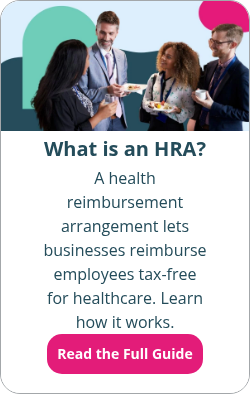How does an HRA work?
By Holly Bengfort on March 14, 2024 at 6:30 AM
Offering traditional group health benefits has grown increasingly difficult for small and mid-sized organizations. It can often be too costly, complex, or rigid in structure.
For those reasons, many employers find that a health reimbursement arrangement (HRA) is the better option when it comes to stretching health benefit dollars. It allows employers to offer their employees tax-free dollars they can spend on their qualified health expenses, including their monthly premiums for health insurance.
In this article, we'll go over the basic structure of an HRA, three popular types of HRAs, and how you can manage your health benefit.
Takeaways from this blog post:
- The basic structure of an HRA involves the employer establishing a monthly allowance. Employees then request reimbursement for medical expenses and provide documentation of their purchases.
- HRAs and HSAs are tax-advantaged ways to cover healthcare costs but have key differences, such as ownership of funds and contribution sources.
- HRAs come in different types, like the QSEHRA, ICHRA, and GCHRA, each offering unique benefits and flexibility for employers.
What is an HRA?
An HRA, often mistakenly called a health reimbursement account, isn't health insurance. An HRA is an employer-funded, IRS-approved, and tax-free health benefit employers use to reimburse employees for qualified medical, dental, or vision expenses. Depending on the type of HRA, these can include individual health insurance premiums, hospital expenses, pharmacy expenses, over-the-counter medicine, and other out-of-pocket medical expenses.
What is the basic structure of an HRA?
Every type of HRA follows a simple, four-step process. First, employers offer their employees a monthly allowance dedicated to health spending. Employees pay out-of-pocket for their own health insurance coverage, including the care they need. Employees then submit proof of their qualified medical expenses for tax-free reimbursement. Once the employer or HRA administrator approves the expense, the employer reimburses employees up to their set allowance amount.
Let's look at the steps in more detail in the sections below.
The employer sets an allowance amount
The organization offering the HRA chooses a monthly benefit allowance of tax-free money to offer each employee. Depending on the type of HRA, the organization may be able to offer different allowance amounts to different employees based on bona fide job criteria. Employers don't need to pre-fund these allowances.
This gives employers a cost-effective way to take care of their employees. The employer can design the plan to meet the organization's unique needs and budget. Whether they offer $500 or $1,500 each month, their employees can put that money to good use. Plus, employers can decide which expenses they want to reimburse.
Employees use their allowance on the medical expenses that matter most to them
Depending on the HRA offered, its flexibility allows employees to pay for the qualifying care, treatment, supplies, and insurance premiums that work best for them. As mentioned above, the employer will typically outline what qualified expenses are included in their benefit.
No two employees are alike. They have different wants, needs, lifestyles, and health concerns. It's easier to support diversity and inclusivity with an HRA than a one-size-fits-all traditional group health insurance plan. By offering this well-rounded health benefit, each employee has the freedom to choose the unique medical services and best local healthcare providers for their needs.
For employers, HRAs are a great way to eliminate many of the administrative headaches associated with group health insurance while offering a comprehensive health benefit. This also makes it simpler for multi-state employers and remote companies to easily offer a benefit that works for everyone.
Employees submit proof of purchase
After the employee incurs an eligible expense, they submit documented proof of the expense to their organization. This documentation must include a description of the product or service, the cost of the expense, and the date the employee incurred the expense. Invoices or receipts typically satisfy this requirement, as does an explanation of benefits (EOB) from the employee's insurer. Employees may need a doctor's note for certain expenses.
The employer reimburses employees
The organization reviews the employee's submission and, if it qualifies, reimburses the employee from the monthly allowance for that benefit. The organization must follow a declined claims and appeals process outlined in its HRA plan documents if the expense doesn’t qualify. Typically, employers include the reimbursement in the employee's next regular paycheck without including it as gross income and without payroll taxes. As long as the employee has minimum essential coverage (MEC), they will not need to report this money as income at the end of the year.
HRA vs. health savings account (HSA)
An HRA is often confused with a health savings account (HSA), and that could be because they sound so similar. HRAs and HSAs can help cover healthcare costs by using tax-advantaged money to fund employee medical expenses. However, these two health benefits differ in many ways.
Here are a few primary differences between an HSA and HRA:
|
Feature |
HSA |
HRA |
|
Who owns the benefit? |
An HSA is owned by the employee rather than the employer. This means if an employee leaves your organization, they can take their HSA funds with them. |
The employer owns the HRA benefit. HRA funds stay with the employer if an employee leaves or doesn’t use their total allowance, enabling further cost savings compared to traditional group health insurance. |
|
Who can contribute to the benefit? |
Contributions to HSAs can come from both the employer and the employee. |
Only the employer can contribute to an HRA. |
|
Tax status |
Employees can claim a tax deduction for contributions they make to their HSA. |
HRAs are tax-free for the employer. Reimbursable expenses also won't count as part of the employee's taxable income as long as they are eligible for the benefit and have MEC. |
|
Annual contribution limits |
With an HSA, there's an annual contribution limit. |
Annual contribution limits for HRAs depend on the type you offer. Most HRAs have no annual contribution limits. We’ll explore the different types of HRAs in the next section. |
|
Is the benefit pre-funded? |
Employers and employees must pre-fund an HSA. Often, employers use HSA debit cards that employees can use to pay for medical services on the spot. |
There’s no need to pre-fund an HRA. HRA funds are generally only available for reimbursement with an approved receipt once the employee purchases the item or service. |
|
Eligibility |
To be eligible for an HSA, an employee must have an HSA-qualified high deductible health plan (HDHP). |
Eligibility depends on the type of HRA you offer. Depending on the type of HRA, employees will need either an individual health insurance plan or a traditional group health plan. |
|
Annual rollover |
If you have unused money left in your HSA at the end of the year, it will roll over to the following year. |
Annual rollover for HRA allowances depends on the type of benefit and how you design it. |
What are the different HRA types?
Several types of HRA plans are available, each offering tax benefits. Three popular options are the qualified small employer HRA (QSEHRA), the individual coverage HRA (ICHRA), and the integrated HRA, also known as a group coverage HRA (GCHRA).
When choosing the right HRA for your organization, here's a rough guideline to follow:
- QSEHRA: Use a QSEHRA if you're an organization with fewer than 50 full-time equivalent employees (FTEs) looking for easy-to-manage, simple-to-deploy health benefits. You can’t offer a QSEHRA alongside a group plan.
- ICHRA: Use an ICHRA if you want the flexibility to offer different allowances to different classes of employees, such as full-time employees or part-time employees. You should also use an ICHRA if you want to ensure your employees purchase individual health insurance policies with their allowances. You can’t offer a group health plan and an ICHRA to the same class of employees.
- GCHRA: Use a GCHRA if you want to supplement an existing group health insurance plan by reimbursing employees for out-of-pocket costs such as deductibles.
Let's dive into each option to give you a better idea of how they work.
How does a qualified small employer HRA (QSEHRA) work?
When Congress passed the Affordable Care Act (ACA), it essentially limited HRAs to pairing with group plans only. That changed in December 2016 when Congress made a formal exception on HRAs with the passage of the 21st Century Cures Act1. The law created the QSEHRA, a personalized health benefit for organizations with fewer than 50 FTEs.
The QSEHRA allows small businesses and nonprofits to reimburse employees for health insurance premiums and out-of-pocket medical expenses. Any employee with MEC can get tax-free reimbursements, including those on a parent’s or spouse’s group plan.
There are annual limits on employer contributions with a QSEHRA. In 2026, annual employee allowances are limited to $6,450 for self-only employees and $13,100 for employees with a family. Employers must offer allowances on the same terms to all eligible employees, and an organization can't offer different allowance amounts to different employees unless those differences are based on family status. Additionally, QSEHRA participants must coordinate their allowance with any premium tax credits. If an employee’s QSEHRA allowance is affordable, they can’t collect any tax credits. If their allowance is unaffordable, they must reduce their tax credit by the amount of their QSEHRA allowance.
A QSEHRA is ideal for small organizations with fewer than 50 FTEs that want a health benefit that’s affordable and easy to manage.
How does an individual coverage HRA (ICHRA) work?
On June 20, 2019, the IRS published Health Reimbursement Arrangements and Other Account-Based Group Health Plans2. This formalized then-President Trump's 2017 executive order to create new HRAs. In addition to expanded coverage for short-term plans, these rules created the ICHRA and the excepted benefit HRA (EBHRA), which employers could begin offering to employees on January 1, 2020.
Unlike QSEHRA, the ICHRA places no limits on the allowance amount employers can set. In addition, employers can set different allowance amounts according to job classifications, like full-time, part-time, salaried, hourly, or where employees are located.
Employers can also offer an ICHRA alongside a group health insurance plan, as long as the class of employee offered an ICHRA is not also offered group health insurance.
Employees using an ICHRA are required to have individual health insurance coverage with MEC. They must purchase a plan through the HealthCare.gov3 site, their state's individual insurance exchange, or a private exchange. Employees who qualify for premium tax credits and are offered an ICHRA must forgo their tax credits if their employer offers an ICHRA allowance that’s considered affordable according to IRS regulations. If the allowance is considered unaffordable, they may keep their premium tax credits and opt out of the ICHRA.
The ICHRA is ideal for organizations of any size that want the flexibility to offer different benefits to different classes of employees who might also want to offer a greater allowance than the QSEHRA allows.
How does a group coverage HRA (GCHRA) work?
The GCHRA enables employers to supplement a group health insurance plan. These HRAs are available to organizations of all sizes and are a way to enhance your benefits.
An organization offering a GCHRA can choose to offer different allowance amounts to different employees based on bona fide job criteria. Eligibility is limited to employees also participating in the organization's group health insurance policy.
Employers can reimburse employees for any eligible out-of-pocket expense, though the employer may choose to limit what they reimburse. Employees with a GHCRA can't receive reimbursement for insurance premiums of any kind.
Employers may choose to request an EOB from their group carrier to receive reimbursement for out-of-pocket medical costs.
A GCHRA is ideal for employers who have an existing group health insurance plan they want to supplement, either to take the bite out of a high-deductible plan or to enhance a feature-rich health benefits package.
Why should you use an HRA administrator to manage your benefit?
While each HRA works slightly differently, all of them are held to many of the same sets of federal requirements, such as HIPAA, ERISA, and IRC. Since these requirements can be challenging to follow, many small business owners choose to implement their HRA benefits through HRA administration software.
PeopleKeep makes it easy to manage your employee benefits with our cloud-based administration platform. We take the hard work out of offering an HRA by performing documentation reviews for all submitted employee expenses, providing customer support, and generating your plan documents to avoid compliance and privacy complications.
With PeopleKeep, small and midsize organizations can ensure they deploy a compliant health benefit that they can manage in just minutes each month.
Conclusion
As the cost of traditional health plans grows, HRAs are becoming increasingly popular among small businesses. There are several types of HRAs available, including the QSEHRA, ICHRA, and GCHRA.
Offering an HRA is a cost-effective way employers can help stretch healthcare dollars. By reimbursing eligible healthcare expenses, employers make it easier for their employees to afford the medical care they need. Plus, adding an HRA to your benefits package also makes it easier to recruit and retain talented employees.
This post was originally published on February 22, 2018. It was last updated on March 14, 2024.
Check out more resources
See these related articles

What is an HRA?
Learn what a Health Reimbursement Arrangement (HRA) is, how it works, and how it benefits both employers and employees in managing healthcare costs.

How your employee benefits package can foster inclusivity
Discover how an inclusive benefits package can foster workplace inclusivity. Learn which benefits support diversity and meet employee needs.

What is a field marketing organization (FMO)?
This article breaks down what field marketing organizations (FMOs) are, how they work, and how they help insurance agents and brokers grow their businesses.



